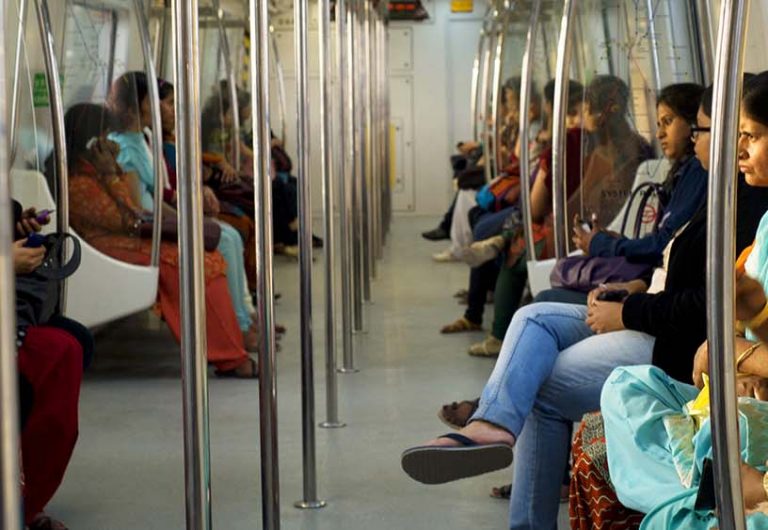New Delhi: On a wintry weather’s day in early 2018, 23-year-vintage records entry government Sheela* needed to make a break up-2nd choice while the motive force of her shared mini-van overlooked her requests to sluggish down and drop her off: she may want to both live at the car–the lone passenger–and possible risk attack, or jump off the moving vehicle and threat damage.

She selected to leap off, injuring her right arm and ankle to make certain her protection from the driver of the grain seva (rural provider) van, a preferred mode of delivery within the low-earnings suburbs of India’s capital. Traveling extra than 7 km from a workplace in Okhla Phase I in southern Delhi to her domestic in Dakshinpuri, the shared van Rs 5 consistent with trip versus no less than Rs 10 in line with km for an automobile became the best dependable and low priced delivery option for Sheela, in a metropolis with three,900 buses and an 8-line, 373-km metro-rail network.
Sheela is considered one of many girls who navigate dangers at the streets of Delhi while going about their each day sports. The recent assertion via the Delhi Chief Minister, Arvind Kejriwal, to make metro and bus rides unfastened for ladies in the metropolis, has key implications for women’s mobility, which, in turn, is connected to selections approximately education, employment, and get right of entry to public areas.
Contrary to the expectation that ladies in city regions get greater employment possibilities, the information display that India’s female labor force participation charge in towns is lower than in rural regions. In the town of Delhi inhabited by more than 19 million human beings and teeming with department stores, cafes, and towering workplace blocks no greater than eleven.7% of ladies above the age of 15 years are in employment, compared to the countrywide common of 27%.
Wife with infant walks, the husband takes a motorbike
In my studies on girls and carrier work in Delhi, younger ladies searching for work raised worries over protection, accessibility, and affordability of public transport. Take the case of 29-year-vintage Sushma, a car motive force. After she got married and moved to Delhi from a village in Rajasthan, Sushma became keen to study further and locate employment. She had heard approximately driver-schooling classes for women and informed her husband that she desired to sign on. However, her in-legal guidelines discouraged her, telling Sushma that her vicinity was at home.
Sushma instructed me their attitude became “massive trouble.” They did not supply her money to tour, and her husband passed over his income to his mom. “I had to ask her for money constantly,” said Sushma, who completed Class XII after marriage. “From Sangam Vihar, I used to walk all of the manners to Kalkaji [6 km]. That’s how I’ve made it on this line. If I hadn’t worked this difficult, we wouldn’t be here these days.”
Sushma attributed her willingness to walk for over an hour to wait for riding classes each day to her stubbornness and her preference to do something along with her life. Now hired as a motive force, Sushma has come to be a breadwinner for her own family. Similarly, Rama, 24 years antique, instructed me that she usually wanted to “do more” with her lifestyle. A network worker for a non-government employer, Rama, with a toddler in hand, commutes ninety minutes each way (12 km), taking walks and partially on buses from Badarpur close to the Faridabad border to Khirki Extension in south Delhi, 5 days a week.
Although the town’s metro network now extends to Badarpur, Rama says she can not manage to pay for journeying with the metro’s aid or taking an auto to the bus forestall. She walks to the bus prevent and takes buses to save a Rs 40 a day automobile fare. “I can’t have the funds for that,” said Rama. “So, I leave early. It takes 20-25 mins with an infant to stroll by myself; it could be faster.” Rama’s husband, a manufacturing facility employee in Okhla, travels by the aid of a bike. Rama and her husband sold the bike on a mortgage that they’re now paying again thru installments from both their salaries.
Transport is a gender difficulty.
The experiences of girls like Sheela, Sushma, and Rama, attempting to relax emerging employment possibilities, highlight how public transport is particularly a gender difficulty. While some have criticized the provision of loose public delivery for girls as discriminatory in opposition to (working elegance) guys, Kejriwal himself drew attention to the hassle of ladies’ protection.
Sheela jumped off the transferring grain sewa van because she felt hazardous as a lone girl passenger. The elevated presence of girls on public delivery will contribute closer to making it friendlier for women. However, the intensified need for dependable public shipping for girls isn’t constrained to the issue of protection.
Women’s mobility is likewise confined with the aid of households via financial management, as turned into the case for Sushma. Further, even when girls can argue for their mobility, they’re probably to must depend on the cheapest public transport or walk. On the other hand, men like Rama’s husband may be capable of using motorbikes if their households can find the money for it. Likewise, it is no longer uncommon for girls employees to take kids with them to paintings, given that home and worrying obligations fall disproportionately on ladies.
